|
July 1954 Popular Science
 [Table of Contents] [Table of Contents]
Wax nostalgic about and learn from the history of early
electronics. See articles from
Popular
Science, published 1872-2021. All copyrights hereby acknowledged.
|
In 1933,
Karl Jansky, at
Bell Telephone Laboratories, reported electromagnetic radiation coming from the
center of our Milky Way galaxy in the direction of Sagittarius. It was the first
time radio signals were knowingly detected in space. I say knowingly because
there were likely others who noticed the energy but did not realize their
source. This, by the way, was not the
cosmic microwave background radiation (CMBR) that Penzias and Wilson
discovered, also at Bell Labs, a decade later in 1964. Reported in this 1954
issue of Popular Science magazine are advances made in radio astronomy
since the early efforts to detect and map the radio sky as a supplement to the
visible light map. In most cases at the time, "radio stars" were coincident with
known visible light stars; however, new stars were discovered which had no
visible signature. Since that time, with the advent of larger telescopes and
vastly more sensitive light detectors, many of those radio-only stars have been
determined to also have a visible light component. Quite interestingly, the
author mentions, "Many radio stars outshine the sun in radio 'brightness.' A
bright one in the constellation of Cygnus, the Swan, was the first discovered,
by Australian observers." Could this have been
Cygnus X-1, the first
x-ray star determined to be a black hole, which was discovered in 1971?
Looking into Space with Radio Eyes
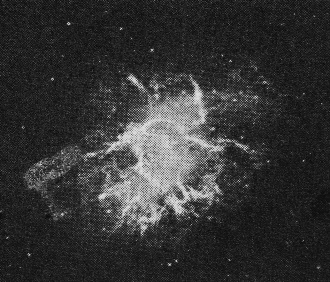
Something new was added to astronomy six years ago, when scientists
discovered the first radio "star." Now they are ... Looking into Space with Radio
Eyes
By P. A. O'Brien
Cavendish Laboratory, Cambridge
The world's largest radio telescope has gone into service at Cambridge, England.
Four parabolic sections, each 300 feet long and 40 feet wide, focus incoming radio
waves upon antennas to locate radio "stars" - heavenly bodies that radiate at radio
frequencies.
Radio astronomy is a new science. The first radio star was discovered in 1948.
Now more than 200 are known; and Cambridge's new radio telescope should increase
this number to about 1,000. Some actually are nebulae, but our sun, a faint radio
star, is one example of a true star among them. They account for mysterious hissing
radio noises from nowhere on earth, which observers since 1931 had tried to trace
with the directional aerials called radio telescopes.
A new window into space opens to radio astronomy. Now astronomers can observe
the skies by radio waves, as well as by visible, ultraviolet and infrared light.
All are electromagnetic waves, differing only in wave length. And radio waves that
pass unhindered through the earth's atmosphere, ranging in length from 1/4 of an
inch to 60 feet, offer a vast spectrum thousands of times as extensive as the visible
one.
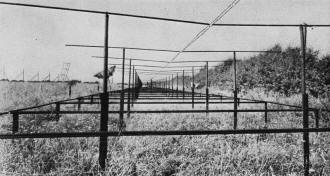
Survey of 50 radio "stars" in the Northern Hemisphere used pair
of 240-foot aerials, one of which is seen below. Crab Nebula (photo at t top of
page) is one of the brightest.
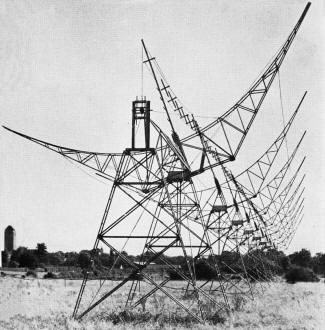
Largest Radio Telescope peers into space at Cambridge, England.
Four 300-foot parabolic sections like this one are arranged at the corners of a
160-by-1,800-foot rectangle.
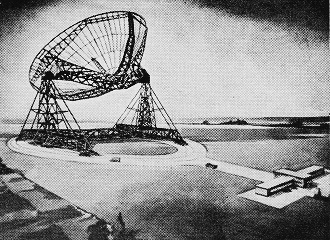
Largest of Bowl-Type radio telescopes, this 250-foot-diameter
giant is being built at Manchester, England. Two high towers will rotate with it
on a circular railway track.
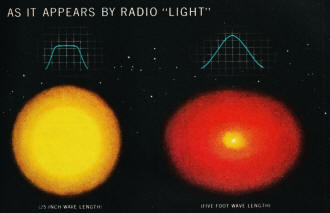
Radio "Light," by which radio telescopes see, resembles visible
light that optical telescopes use. Both are electromagnetic waves, differing only
in wave length.
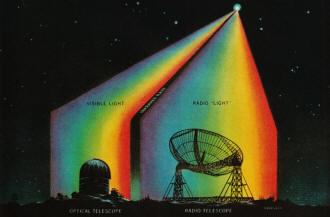
Diagram shows where they fit into a continuous spectrum, with
wave length increasing from left to right. Radio "colors," really invisible, are
pictured as if like visible hues. So far does radio band exceed visible one in extent,
that drawing cannot be to scale.
Because of radio waves' similarity to light, a radio astronomer can do far more
than listen to static from the stars. He views heavenly objects and makes actual
pictures of them by radio "light."
Seeing the Sun by Radio
How does the sun "look" by radio? Its disk swells in apparent size. According
to the wave length used, a bright ring may encircle it - or its shape may startlingly
change from round to oval.
Sunspots, dark to the eye, become far brighter than the rest of the disk, vividly
flickering and flaring.
The sun looks bigger by radio waves because they come mostly from its atmosphere
- which we see only in a total eclipse, when scattered light from the sun's surface
forms the faint pearly white corona. Appearance changes with wave lengths because
different ones come from different heights. Radio astronomy unexpectedly finds the
sun's upper atmosphere at million-degree temperature, compared to its 6,000-degree
surface.
Many radio stars outshine the sun in radio "brightness." A bright one in the
constellation of Cygnus, the Swan, was the first discovered, by Australian observers.
Soon after, the brightest of all was found in the constellation of Cassiopeia by
Martin Ryle and his Cavendish Laboratory group at Cambridge.
Precise measurements at Cambridge of the two "stars'" positions were sent to
Mt. Palomar, and photographs with the 200-inch telescope showed two strange objects
faintly visible there.
New-Found Wonders of the Sky
The Cassiopeia radio star proves to be a nebulous, 100,000,000-mile-diameter
Milky Way cloud in a chaotic state of turmoil, with filaments of gas moving at up
to 1,000-mile-a-second velocity.
The Cygnus radio star looks like two distant galaxies in collision! Such swarms
of stars might pass through each other unscathed, in millions of years; vast distances
separating stars would make direct hits unlikely. But gas and dust clouds between
stars could not escape collision. Most of the gas would be left behind at the scene,
and heated to extreme temperature by the impact.
While radio astronomy led to finding these wonders, and more like them, some
radio stars are familiar objects. The third-brightest radio star has been identified
with the famous Crab Nebula in Taurus, the remains of a supernova or exploding star.
Notably the brightest radio stars have one thing in common - diffuse gaseous matter
in violent motion.
Day or night, the "radio sky" is dark and seeing is good for observers at radio
telescopes. Neither clouds nor city lights bother them. But a handicap is their
instruments' inferiority to optical telescopes in resolving power, the ability to
define details clearly, which depends upon a telescope's diameter measured in wave
lengths. It would take a radio telescope as large as the Pacific Ocean to match
the resolving power of the 200-inch Palomar telescope!
What is next-best? One answer is to build a single radio telescope as large as
physically possible. Due for completion at Manchester, England, in 1955 is a bowl-type
radio telescope of record 250-foot diameter, steerable toward any part of the sky.
Under direction of Prof. A. C. B. Lovell, work on the million-dollar instrument
is well advanced.
Another answer is the interferometer-type radio telescope, with two or more aerials,
up to one-third of a mile apart, joined by cables to one receiver. The effect is
as if the aerials were small portions of one gigantic one. The new Cambridge radio
telescope is of this type - a "double interferometer" - unprecedented in resolving
power, as well as in size. To sweep the heavens, it depends upon the earth's rotation.
Meanwhile a wavy line upon a chart records in-coming radio waves' strength. Its
units tilt to cover the sky in strips.
Observations with these two new instruments should bring about the next great
advance in radio astronomy.
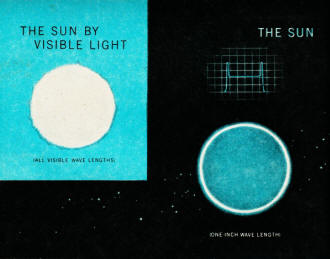
Here's the New Way the sun looks, by radio "light." Bigger than
by visible light (far left), it enlarges with increasing wave length, and its round
shape changes into an oval one (far right on facing page). Another striking feature
is bright ring observed at one-inch wave length. PSM artist's paintings are based
on brightness charts obtained with radio telescope and shown on smaller scale above
them. Colors symbolize different wave lengths. This is an apt analogy, since changing
the wave length alters celestial bodies' appearance much as a change of color filters
does in visible-light observation. Note that visible sky is bright in daytime, "radio
sky" always dark - a boon to radio astronomers.
Posted January 24, 2024
|















